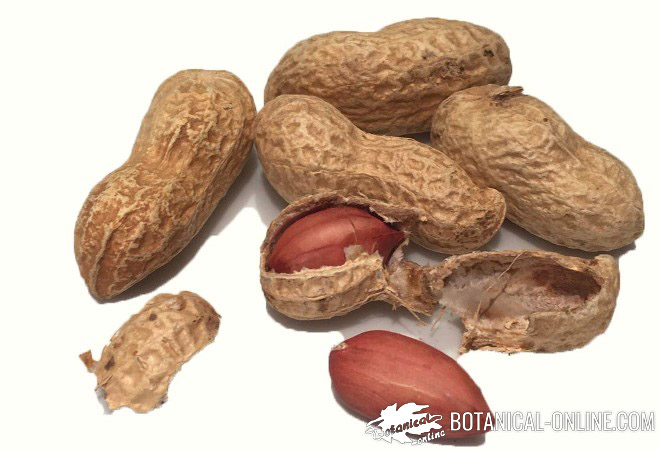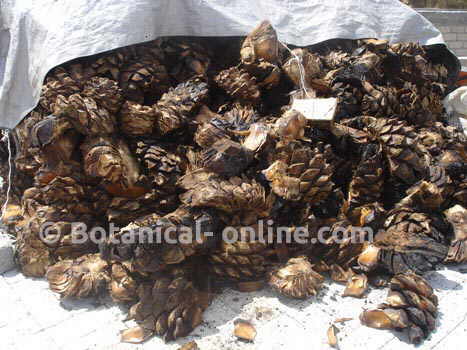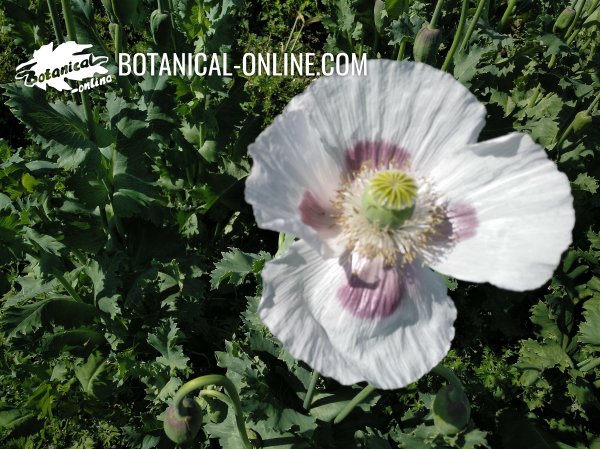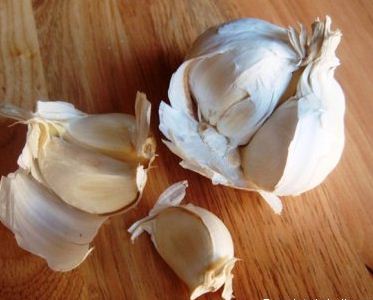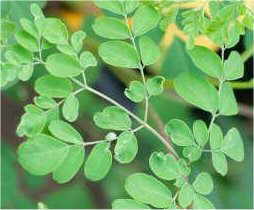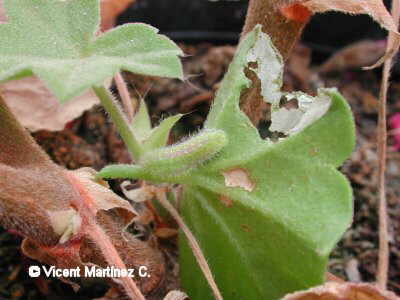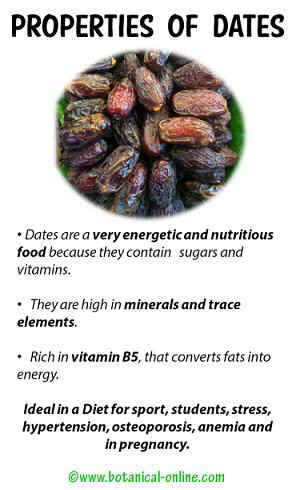Contents
What are sweet potatotes?
Characteristics of sweet potato (Ipomoea batatas)
Common English name: sweet potato, Louisiana-yam (Sur de EE.UU.)
Scientific name: Ipomoea batatas (L.) Lam.
Other taxonomic names:
– Convulvus batatas L. (1737)
– Batata edulis (Thunberg) Choisy (1833)
Family: Convolvulaceae
Origin: Sweet potato is native to tropical America. Although its exact origin is unclear, it is believed that sweet potato is native to northwestern South America, from northern Peru and southern Ecuador. It is in these countries where there is great diversity of types of potato.
Habitat: It appears is in the tropics and subtropics. Currently it has spread its cultivation by the most temperate world.
Distribution: according to historian Merrill (1954), sweet potato was distributed from South America to Polynesia, New Zealand, Papua and the Northern Mariana Islands between the XII and XIII. When Spanish settlers arrived in the New World, the cultivation of sweet potatoes was widespread throughout the American territory. In 1500, they brought it to Spain (even before tomato or corn), from where it spread throughout Europe.
Today, sweet potato is widely grown for its edible tubers. The main producer is China.
Botanical description of sweet potato
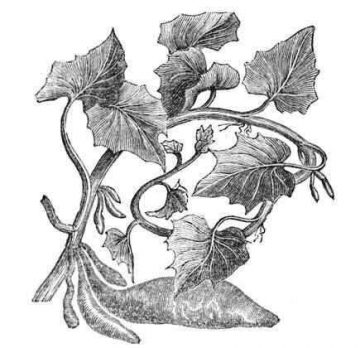
Sweet potato (Ipomoea batatas) is a perennial plant of the Convolvulaceae family, the same one where tangkong or Chinese spinach belong (Ipomoea aquatica = Ipomoea reptans), a plant whose leaves are eaten as vegetables in Southwest Asia.
It is a creeping plant with gnarled stems and adventitious roots. The stem is green or purple, pubescent, 1-2 to 8m. long (depending on cultivar).
Some of their roots are tubers rich in starch and sugars, which are used in food.
This tuberous root, known as sweet potato, can have different shapes and colors depending on the variety grown. The skin and flesh can be white, yellow or orange (because it contains carotene).
Leaves can also differ greatly between different cultivars, and even in the same plant. In general, the potato plant has simple leaves with petioles, ovate or cordate and margins entire, toothed or lobed. They can be pale green or dark green.
Sweet potato flowers grow in clusters or solitary in the axils of the leaves. They are re infundibular flowers or funnel shaped, purple and white. These consist of five sepals, five stamens, two carpels and superior ovary.
It blooms from July to October. Its flowers open in the morning and close in the afternoon.
The fruit is a dehiscent capsule, round, 3 to 7mm. in diameter, which in its interior contains between 1 and 4 seeds.
Used parts
- Tuber: the tuber of the plant is edible, rich in starch, fiber, B vitamins and minerals. There are several varieties, among the most common, there are two types: white pulp sweet potatoes and orange pulp sweet o. These tuberous roots are consumed as food and to feed animals.
* More information about the nutritional value of sweet potatoes.
- Leaves: the tips of the young shoots are eaten as a vegetable, boiled or in salads.
| Botanical classification | |
| Kingdom | Plantae – Plants |
| Subkingdom | Tracheobionta Vascular plants |
| Superdivision | Spermatophyta Seed plants |
| Division | Magnoliophyta Flower plants |
| Class | Magnoliopsida Dicotyledonous |
| Subclass | Asteridae |
| Order | Solanales |
| Family | Convolvulaceae |
| Tribe | Ipomoeeae |
| Gender | Ipomoea |
| Species | Ipomoea batatas |
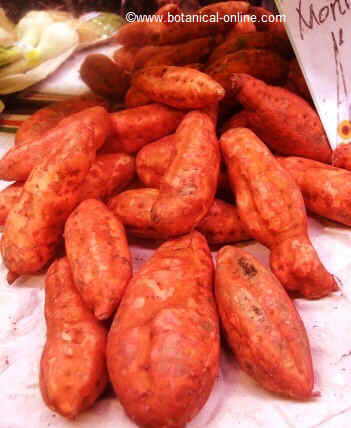
Sweet potatoes as your can find them in the market
Uses of sweet potato
- Food: sweet potatoes are eaten cooked, baked, fried, boiled, in soups, creams and accompaniment. You can not digest it well if taken raw, so it always requires precooking.
You can also buy dehydrated potatoes, frozen, canned, and flour for the production of pastries and cookies. The sweet cream is used as the pumpkin pie filling
The leaves of sweet potatoes are a common vegetable in markets of Southeast Asia, the Pacific, and in parts of South America. Some varieties are used only to obtain their leaves to vegetables. The leaves are rich in oxalates.
- Production of starch: some types of cultivars of sweet potatoes are used for the industrial production of starch.
- Fodder and animal feed: the stems of the plant, known as guides or sweet potato vines and their tuber are used to feed for pigs and cattle. The sweet potato flour is added to poultry feed to provide more color to eggs and meat.
- Medicinal plant: according to historians, the decoction of the leaves was used in ancient times as a natural antibiotic, laxative and tonic.
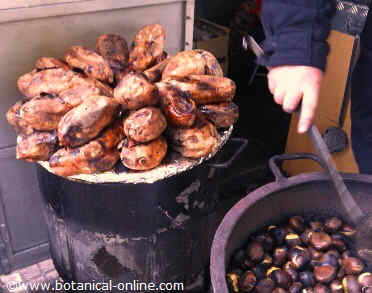
In the picture: Photo of sweet potatoes, as sold in the street stands. In Spain, it is traditional to sell sweet potatoes (orange-fleshed varieties) and roasted chestnuts, when it’s fall and Christmas season
Active components of sweet potato
- Carbohydrates: fructose, glucose, sucrose.
- Protein: the tuber is low in protein, while the leaves have a higher amount. Containing the amino acids: alanine, arginine, cystine, glutamic acid, histidine, glycine, isoleucine, lysine, tryptophan, valine.
- Fat: linolenic acid, linoleic acid, oleic acid, palmitic acid.
- Fiber: pectin.
- Vitamins: Vitamin C, folic acid, niacin, riboflavin, tocopherol.
- Minerals: potassium, magnesium, iron, phosphorus, manganese, copper, zinc.
- Flavonoids: quercetin, isoquercitrin.
- Carotene and plant pigments: phytoene, phytofluene, cyanidin, anthocyanins, peonidin, carotenoids, beta carotene, zeta-carotene.
- Organic acids: aspartic acid, batatic-acid, caffeic-acid, oxalic-acid, trans-cinnamic acid, uronic acid.
- Phytosterols
- Calcium oxalate
- Glucoside: scopoletin
- Ipomoeanine, ipomoeamarone
- Alkaloid: ipomine A (laxative)
Composition of sweet potato
Composition of sweet potato per 100g | ||
Nutrient | Leaves | Tubers |
| Calories (kcal.) | 35 | 105 |
| Carbohydrates (g.) | 6,38 | 24,28 |
| Proteins (g.) | 4 | 1,65 |
| Fat (g.) | 0,30 | 0,30 |
| Fiber (g.) | 2 | 3 |
| Vitamin C (mg.) | 11 | 22,70 |
| Vitamin B1 or thiamin (mg.) | 0,16 | 0,07 |
| Vitamin B2 or riboflavin (mg.) | 0,35 | 0,15 |
| Vitamin B3 or niacin (mg.) | 1,13 | 0,67 |
| Vitamin B6 o pyridoxine (mg.) | 0,19 | 0,25 |
| Folates (mcg.) | 80 | 14 |
| Calcium (mg.) | 37 | 22 |
| Magnesium (mg.) | 61 | 10 |
| Phosphorus (mg.) | 94 | 28 |
| Sodium (mg.) | 9 | 13 |
| Potassium (mg.) | 518 | 204 |
| Iron (mg.) | 1,01 | 0,59 |
| Zinc (mg.) | 0,29 | 0,28 |
| Copper (mg.) | 0,04 | 0,17 |
| Selenium (mcg.) | 0,90 | 0,60 |
| Water (g.) | 87,96 | 72,84 |
![]() More information about sweet potato.
More information about sweet potato.


